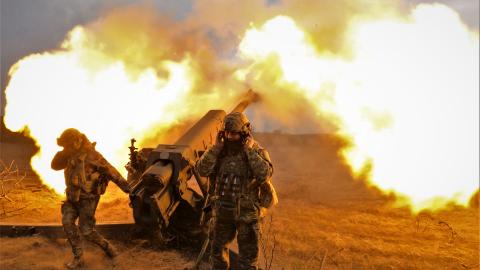This report first appeared as a part of Hudson's Re: Ukraine newsletter series. To subscribe, click here.
Below Hudson Senior Fellow Can Kasapoğlu offers a military situational report about the war in Ukraine.
1. Iranian Loitering Munitions in Action Again
On March 17, the Russian military launched a large salvo of Iran-made Shahed-131 and Shahed-136 loitering munitions, according to Yuriy Ihnat, the spokesman of the Ukrainian Air Force. The strike’s target set resembled that of previous attacks, damaging critical infrastructure in the Ukrainian cities of Kyiv, Dnipropetrovsk, Zaporizhzhia, and Lviv.
Russia launched the strike packages from Krasnodar and Bryansk, which fall, respectively, under the Southern Military District and Western Military District’s areas of responsibility. Previous editions of Hudson Institute’s Ukraine Military Situation Report anticipated that Bryansk could serve as a launch site for Iran-made drones. This week’s attacks confirmed those intuitions.
The Ukrainian Armed Forces managed to down 11 of the 16 Shahed-131 and Shahed-136 loitering munitions, an interception rate of nearly 70 percent. While that interception rate surpassed the Ukrainian air defenses’ worrisome performance against the Russian strike of March 9, a 30 percent penetration rate will still result in considerable damage in offense-dominant drone warfare.
2. Ukraine Reportedly Targets Russian Kalibr Missile Transfers in Crimea
This week Ukrainian Armed Forces targeted Dzhankoi, a regionally significant town in northern Crimea. According to Ukrainian Defense Intelligence, the strike destroyed Russian Kalibr naval-launched cruise missiles being transported to the Black Sea Fleet. Initial findings suggest that Ukrainian forces used kamikaze drones in the attack.
Since making its combat debut in Syria, the Kalibr cruise missile has equipped the Russian Navy with long-range conventional strike capabilities. As a result, both the Black Sea Fleet and the Caspian Flotilla have regularly attacked Ukrainian soil. Recently, the Black Sea Fleet’s improved Kilo-class submarines have led the Kalibr salvos.
The Ukrainian military’s Dzhankoi strike is important for several reasons. First, and most importantly, it shows that Ukraine can strike the Russian rear, especially logistics hubs and bottlenecks, decisively.
Second, it demonstrates Ukraine’s military-intelligence prowess, which achieved real-time tracking and elimination of a Russian strategic weapons system delivery. Such a potent effort suggests well-functioning coordination between a complex sensors network and high-precision strike assets.
Third, the strike diminishes the stocks of one of the Russian military’s most important assets. Defense intelligence estimates show that the Russians have unleashed around 500 Kalibr missiles since the beginning of the invasion. With the Russian arms industry capable of producing only 120 units of Kalibr cruise missiles per year, and production capacity under stress from sanctions due to the missile’s reliance on Western components, Ukraine has struck a precious commodity when Russia can ill afford it.
3. Tactical Update: Bakhmut and Avdiivka
Russia’s push for Bakhmut, spearheaded by Wagner units and airborne troops (VDV), continued this week with incremental gains in the northern and southwestern areas of the Bakhmut battleground. Our monitoring continues to suggest that the battlefield geometry and rate of attrition still favor the Russian occupation. Nevertheless, the Ukrainian military is skillfully rotating combat formations and sending reinforcements. Evidence suggests that the 93rd Mechanized Brigade is still holding its defensive positions within the city. Ukraine’s leaders have continued to insist on holding the town, despite the highly attritional deadlock that could hamper a long-awaited Ukrainian spring counteroffensive, likely in the south.
Avdiivka, a city in the Donetsk Oblast, also played host this week to heavy clashes and Russian military activity. Available indicators suggest that Avdiivka and Bakhmut will remain at the center of Russian efforts in the coming weeks.
Visual evidence from the region indicates that Ukraine’s infamous rasputitsa, a season when rain and melting snow make roads muddy and travel difficult, is now emerging. The soupy terrain may impede armored and mechanized operations in the coming weeks. In the meantime, Ukrainian servicemen continue their Western main battle tanks training in multiple locations.
4. Ukrainian Personnel Finish European SAMP/T Air and Missile Defense System Training
This week the Ukrainian military completed its training on the SAMP/T, a European air and missile defense system, and is now set to receive it. Together with the American-made Patriot surface-to-air missile (SAM) system, the European SAMP/T will increase the Ukrainian military’s strategic air defense deterrent.
The SAMP/T comes with a highly capable sensors edge. Its three-dimensional X-band Arabel radar resists electronic warfare measures. The Arabel radar features 360-degree coverage, providing defensive capabilities against incoming threats from any angle. The radar system can track up to 100 targets while managing up to 16 interceptors for active engagement. More importantly, just like the Patriot, the SAMP/T is Link-16 compatible, so Ukraine can use it in network-centric, layered air- and missile-defense tasks with other Western systems.
When the SAMP/T’s Aster-30 missile closes in on a target, an active Ka-band AD4A doppler radar seeker in its nose leads the engagement guidance. Gas thrusters enabling side-strafing corrections boost its interception capacity. The Aster-30 baseline’s tests included the Israeli Black Sparrow target missile, mimicking Scud missiles and their derivatives.
The Ukrainian Armed Forces’ ongoing capability-development efforts, centered on Patriot and SAMP/T systems, remain important for two reasons. First, field reports indicate that although Russian Aerospace Forces (VKS) have failed to claim air superiority in the Ukrainian skies, Russia’s airpower still proves a threat. The Ukrainian Air Force, lacking advanced Western aircraft to match the adversary in aerial combat; requires long-range and high-altitude air defenses. Therefore, the SAMP/T and Patriot would make useful additions to the Ukrainian arsenal. Second, evidence suggests that bilateral military ties between Russia and Iran are developing quickly, increasing the likelihood that Russia may soon be operating Iran-manufactured ballistic missiles, along with drones more advanced than those in its current stock.
To that end, media sources have reported that Ukrainian servicemen are on track to complete their Patriot training ahead of schedule. The transformation of Ukrainian air defense stocks from Soviet-Russian weapons to Western strategic SAMs manifests not only a capability leap but also a reorientation of Kyiv’s geopolitical destiny from East to West.



















